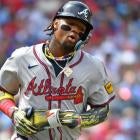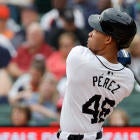Velocity isn’t everything. Anyone who watched Daniel Cabrera blindly whipping 97 MPH fastballs at a lunging catcher knows that.
However, there’s a reason the baseball world has an entire industry devoted solely to improving a pitchers’ velocity, via weighted balls, strength training and high-tech tracking data. If improved velocity isn’t necessarily a magic bullet that can solve any pitchers’ woes, there’s a clear relationship between velocity and pitching success. These two charts compare velocity to strikeout rate and FIP over the past 10 seasons for starting pitchers:


It isn’t a perfect correlation, but there’s a clear relationship: both FIP and strikeout rate tend to improve as fastball velocity increases. Which is why, even though he didn’t exactly see a huge improvement in his performance last season, I’m still more than willing to buy into James Paxton heading into 2017.
Paxton, who spent most of his first few seasons pitching in the low-to-mid 90’s, saw a huge increase in his average fastball velocity last season. After averaging just 91.8 MPH in spring training, Paxton tweaked his mechanics in the minors, dropping his average release point nearly a full foot (2015 is first, followed by 2016):

That tweak unlocked more velocity than Paxton had ever shown, as he returned to the majors in June averaging nearly 98 MPH on his fastball. He was able to sustain high-90’s throughout the end of the season, and even hit 99 MPH on 54 occasions, something Paxton had done just once before in his major-league career, per BrooksBaseball.com. Paxton wasn’t quite the left-handed version of Noah Syndergaard, but at least in terms of velocity, he was the closest thing we had in the majors.
Paxton was able to generate that additional velocity with his lower arm slot, and he didn’t seem to sacrifice much to get there. Paxton lowered his walk rate from 7.4 to 4.7 percent from 2015, upped his strikeout rate from 18.9 to 22.9 percent, and did it without inducing fewer groundballs or surrendering more home runs. Toss all of those factors together, and it’s little surprise Paxton took a huge step forward in his defense-independent pitching stats, lowering his FIP to 2.80, with a 3.35 xFIP and 3.54 SIE
In fact, among 118 pitchers who threw at least 120 innings in the majors, Paxton ranked fourth in FIP, eighth in xFIP, and 15th in SIERA. His 3.79 ERA doesn’t quite tell the story of how much Paxton improved, and it’s possible even his impressive peripherals don’t quite tell the whole story either. The fastball is the headline, but it might not be the biggest reason to be excited about what Paxton is capable of this season.
That’s because Paxton might be able to back his heater up with two plus secondary offerings. Paxton’s low-90’s cutter was a true weapon in 2016, limiting opposing batters to just a .176 batting average against and .088 ISO. His low-80’s curveball might have been even better, producing a .234 average and only an .039 ISO. Despite accounting for 28.4 percent of his total pitches, just 19.5 percent of his extra-base hits allowed came against the two pitches.
Paxton’s swinging strike rate on the cutter was 23.6 percent, the best in baseball among all pitchers who threw at least 200 of them; that rate is more than double the average for the pitch. His curveball had just the ninth-best swinging strike rate, but at 18.1 percent, was still well ahead of the average, at 12.3 percent.
So, Paxton doesn’t just come to the mound with one of the hardest fastballs in the league, but he also had two of the best secondary pitches in 2016. His changeup lagged well behind those other two pitches, but he was still able to more than hold his own against right-handed batters, and actually had slight reverse splits.
Paxton might not have prevented runs like an ace last season, but that was just about the only thing he was missing. Once you look under the hood, it’s clear that the changes he made last season made him a much more effective pitcher. With the potential for three plus pitches, and backed up by a playoff contender and what should be one of the best outfield defenses in baseball, Paxton has a chance to take a big step forward in 2017. If you know where to look, it’s clear he already did.






















